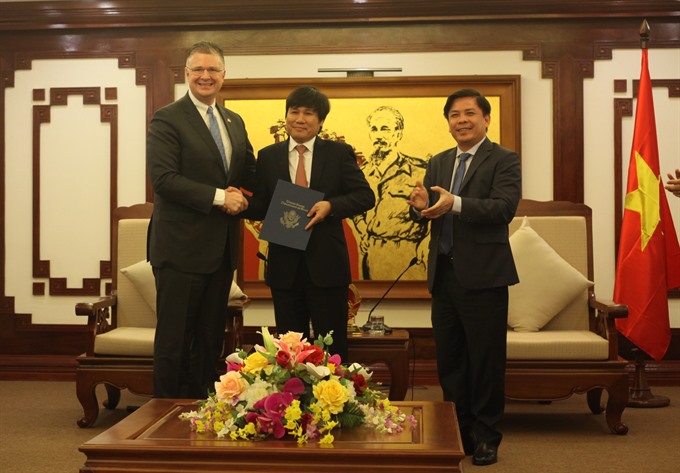 Economy
Economy

Việt Nam on Thursday received a Category 1 aviation safety rating from the US Department of Transportation’s Federal Aviation Administration (FAA).
 |
| US Ambassador to Việt Nam Daniel J. Kritenbrink presents a letter from the FAA to Director General of Civil Aviation Authority of Vietnam Đinh Việt Thắng and congratulates Vietnam on achieving a Category 1 aviation safety rating. — Photo US Embassy |
HÀ NỘI — Việt Nam on Thursday received a Category 1 aviation safety rating from the US Department of Transportation’s Federal Aviation Administration (FAA).
At the US Embassy to Việt Nam in the capital city, US Ambassador Daniel J. Kritenbrink presented a letter from the FAA to Director General of the Civil Aviation Authority of Vietnam (CAAV) Đinh Việt Thắng and congratulated Việt Nam on achieving a Category 1 rating, witnessed by Minister of Transport Nguyễn Văn Thể and leaders of the aviation industry.
The Category 1 status is based on an August 2018 FAA assessment of the safety oversight provided by the CAAV.
It is the result of years of diligent work by the CAAV and the Ministry of Transport.
With Category 1 status, Vietnamese carriers will be able to establish direct services to the United States and carry the code of US carriers upon completion of the necessary remaining steps, including Vietnamese airports earning approval to comply with ICAO security standards and recommended practices from the US Transportation Security Administration, and Vietnamese airlines earning economic authority from the US Department of Transportation.
As part of the FAA’s International Aviation Safety Assessment (IASA) programme, the agency assesses civil aviation authorities of all countries with air carriers that have applied to fly to the US, currently conduct operations to the US, or participate in code sharing arrangements with US partner airlines, and makes the information available to the public.
Thắng said CAT 1 was a mandatory condition for airlines to open routes to the US.
To achieve CAT 1, Thắng said Việt Nam had to do a lot of things.
“We had to check and finalise eight issues according to set standards by the International Civil Aviation Organisation (ICAO) that are related to the legal system, flight safety standards and regulations and specialized guidelines on training, especially for key personnel involved in air safety assessment,” Thắng said.
The CAAV had been preparing since 2012 for the evaluation of CAT 1 with active support from Boeing. After studying the regulations on flight safety inspections and supervision of the US FAA, we found the regulations were very complicated and demanding,” Thắng added.
Việt Nam was issued with CAT 1 certification after failing twice. The first CAT 1 test was conducted in 2013 and founded 49 problems that needed to be considered, more than half of which related to air safety. The second test took place in 2017 in response to the new requirements for opening routes to the US. The result was evaluated by the FAA quite well but there were still some points that needed to be improved.
Thắng said obtaining CAT 1 was very difficult in the first place, but it was even more difficult to maintain CAT 1. The aviation market was developing strongly with an increasing number of aircraft, airports and the volume of flight operations. The FAA required aviation authorities to regularly strengthen their management capacity, including high demand for human resources training.
“In terms of human resources including personnel on flight supervision and flight safety supervision, the quantity and quality must be increased to meet the development speed of airlines. This is really a huge challenge and some countries in Southeast Asia that have met CAT 1 standards have been re-evaluated,” Thắng said.
Determining human resources is a key factor to maintaining CAT 1, the CAAC has started a programme to supplement and enhance human resources for all its supervisors from now to 2025.
According to Thắng, domestic airlines including national flag carrier Vietnam Airlines, newly-launched Bamboo Airways and budget-carrier Vietjet Air have plans to promote direct flights to the US.
Vietnam Airlines CEO Dương Trí Thành said Vietnam Airlines had opened a representative office in the US in 2001. Over the past 10 years, the firm had prepared the technical and commercial conditions for opening routes to the US. Although there was still no direct route, it had partnered with airlines to connect flights and offer products on routes to the US since 1996.
“As the national carrier, Vietnam Airlines considers the opening of a direct route to the US a political task so it has been studying this route for many years. The commercial feasibility heavily depends on aircraft technology,” Thành said.
Thành said Vietnam Airlines expected to have aircraft that could fly directly to the US by 2022.
“Opening routes to the US will challenge Vietnamese airlines. It will be costly to invest in a suitable long-range fleet to the US. In addition, the aviation market is a fierce market as there are many airlines from various countries already flying to the US and many US airlines operating routes from the US to other countries,” Thắng said.
Direct flights to the US would suffer losses in the beginning, but were expected to be effective in the long run, Thành added. — VNS